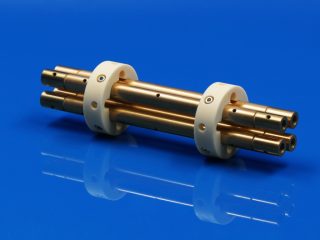In industries and research fields where maintaining a precise vacuum is crucial, the High Vacuum Ionization Gauge emerges as an indispensable tool. This sophisticated device is designed to measure the vacuum degree within a chamber by leveraging the ionization of gas molecules. Innovacera, a leading manufacturer in advanced ceramic products, produces high vacuum ionization gauges that are essential for laboratories, industrial applications, and scientific research.
How Does a High Vacuum Ionization Gauge Work?
At its core, a High Vacuum Ionization Gauge functions by ionizing gas molecules within a specialized chamber. The process begins when gas molecules enter the ionization chamber and are subjected to ionization methods such as heated wires or electron beams. This ionization process generates positive ions and free electrons. The positive ions are then attracted to an electron collector, while the free electrons create an electric current.

Interpreting the Measurements
The magnitude of the current produced in the ionization chamber is directly related to the density of the gas molecules, which in turn reflects the vacuum level. Generally, a higher current indicates a lower vacuum degree (higher pressure), while a lower current suggests a higher vacuum degree (lower pressure). This precise measurement is vital for applications where maintaining a specific vacuum level is crucial to the success of the process.
Versatility in Measuring Range
High vacuum ionization gauges are versatile instruments capable of measuring a wide range of pressures. For low-pressure environments, a larger ionization chamber and higher voltage are utilized, while high-pressure measurements require a smaller ionization chamber and lower voltage. This adaptability makes these gauges suitable for various vacuum conditions, ensuring accurate and reliable readings across different applications.
The Importance of Glass to Metal Seals
One of the critical components in a high vacuum ionization gauge is the Glass to Metal seal. These seals play a vital role in maintaining the vacuum integrity of the gauge by creating airtight connections between different parts, such as the ionization chamber and the electron collector.
Advantages of Glass to Metal Seals
Airtight Connection: Ensures that no external gases can enter the vacuum chamber, maintaining the accuracy of the measurements.
Durability: These seals are designed to withstand extreme conditions, including high temperatures and pressures, which are common in vacuum systems.
Electrical Insulation: The glass component provides excellent electrical insulation, preventing any leakage and ensuring reliable operation.
Metallization: Enhancing Gauge Performance
Metallization is a key process used in the construction of high vacuum ionization gauges, particularly in the formation of glass to metal seals. Metallization involves applying a metal coating to ceramic or glass surfaces, which allows these materials to be bonded with metal components. This process is crucial in ensuring the strength and durability of the seals, contributing to the overall performance and longevity of the gauge.
Benefits of Metallization
Strong Bonding: Metallization creates a robust bond between glass and metal, ensuring that the seal remains intact even under challenging conditions.
Enhanced Durability: The metallized surfaces are better able to withstand the thermal and mechanical stresses encountered in high vacuum environments.
Improved Reliability: By enhancing the integrity of the glass to metal seals, metallization ensures that the high vacuum ionization gauge operates reliably over extended periods.
The High Vacuum Ionization Gauge is an essential instrument in industries and research fields where precise vacuum measurement is critical. By understanding how these gauges operate, the importance of Glass to Metal seals, and the role of Metallization in their construction, professionals can better appreciate the value these tools bring to their work. As technology continues to advance, the demand for accurate and reliable vacuum measurement will only grow, making high vacuum ionization gauges an ever-more vital component in modern manufacturing and research environments.




 Enquiry
Enquiry